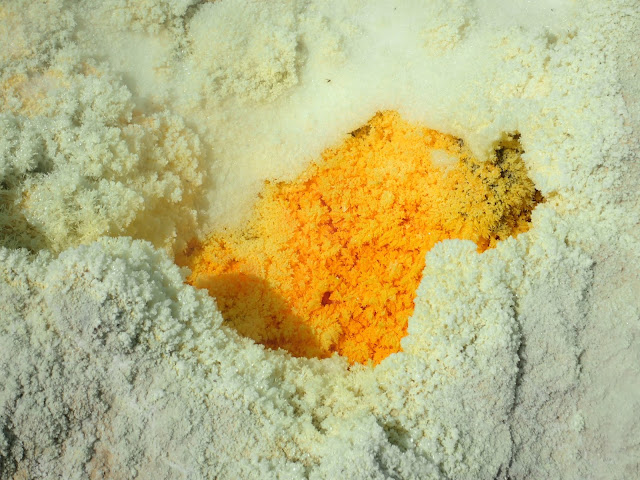 |
| We had just reached the crater. The smoke in the background is sulphuric gas. There were dire warnings to avoid getting close to the gas because of "intoxication". Burning eyes, coughing - toxic, indeed. |
Vulcanos are terrifying, mysterious, intriguing, threatening and always a curiosity. We have seen several in the past years, the Azores, Dominica, and most recently, Nisoros, being the most active and Mt Etna the most spectacular. But we anticipated Isla Vulcano and Stromboli in the Aeolian Islands, an archipelago off Sicily named after the god of wind, would be the most dramatic - still smoking, smelling and spewing. And they did not disappoint in a frightening way.
 |
| Clear demarcation of living from non-living. Our view from Milly's cockpit at the base of the active Gran Cratere. |
 |
| The 'minor' activity within a 200m dash. The yellow sulphur crystals on the rock face showed plenty of action. |
We began with Isla Vulcano. Our anchorage at Porto Di Levante placed Milly not more than 100 meters from a bubbling hot mineral spring in the water off the beach. It looked like a low energy fountain or the underwater jets of a jacuzzi about 1 m in diameter. Two hundred meters away was a rocky promontory covered in sulphur yellow. And, yes, we had definite whiffs reminiscent of the stink bombs my dear brother put under his little sister's bed in many days gone by. Milly was in the midst of volcanic activity with people cavorting in the water all around. Strange.
 |
| A hot mud bath with a distinct sulphur odour did not appeal to us on a hot day. Many others were taking part despite the poster full of warnings at the gate. Included were exact bathing, rinsing, inhaling, robing, sitting in the shade/dark at home, number of days to repeat etc. directions for different ailments with strict timing. |
Although we have no pictures, we snorkelled over the mineral spring which bubbled up between rocks and then ventured over to the rocky promontory. As the water warmed the fish life grew but as the water became bath water hot, the fish disappeared and there was no growth on the sea bottom. And the smell was overpowering - we were glad to be breathing through our mouths with eyes masked. Bubbles of all sizes escaped through rock crevices and holes on the bottom over a very large area making it seem like we were swimming in a giant champagne glass.
 |
| An entrepreneur took full advantage of tourists with only flip-flops to hike in. |
 |
| Green turns to barren. Lipari island in the distance. |
 |
| View of Milly from the beginning of the hike up. An extinct crater in the background. |
The only real village on the island sits right at the base of the active volcano, Gran Cratere, where we were anchored. We hiked up the slope beginning in lush green growth of oleander and pine and ending in a lunar landscape of rock and sulphuric gas vents.
 |
| As long as we were downwind, we could get up close and personal with the vents along the crater's ridge. |
 |
| The crater looked like solid mud. The smoke is coming out of the cracks and holes along the ridge. |
 |
| Miracle flowers in this vast expanse of wasteland. |
 |
| From the highest part of the crater crest |
 |
| Snaking ash and rubble path down the rather steep crater ridge and into the sulphur. |
 |
| Where the gas was venting, the sulphur condensed into beautiful but smelly crystals. Peter was downwind. I was quite far away. |
 |
| It was amazing! |
 |
| Those behind us looked like they were getting a dose of sulphur. |
An experience that was otherworldly and strange. It didn't seem dangerous, the last time it erupted was in 1890. Now, Stromboli was something else altogether and our next stop.











































